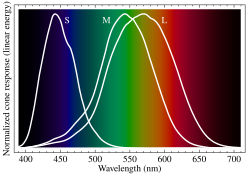Colour vision
Color vision is the capacity of an organism to distinguish objects based on the wavelengths (or frequencies) of the light they reflect, emit, or transmit.
Color is a quality made by the visual brain and so it is not a property of objects, despite what children are taught.[1]
The wavelength reflected from an object is the objective fact: it does not depend upon perception. A 'red' apple does not emit red light.[2] Rather, it simply absorbs all the frequencies of visible light shining on it except for a group of frequencies that are reflected. It is these frequencies which are seen or perceived as red.
Mechanism
The visible light spectrum ranges from about 380 to 740 nanometers. Colors of the spectrum such as red, orange, yellow, green, cyan, blue, and violet are in this range. These spectral colors do not refer to a single wavelength, but rather to a set of wavelengths: red, 625–740 nm; orange, 590–625 nm; yellow, 565–590 nm; green, 500–565 nm; cyan, 485–500 nm; blue, 450–485 nm; violet, 380–450 nm.
The nervous system derives color by comparing the responses to light from the several types of cone photoreceptors in the eye. These cone photoreceptors are sensitive to different portions of the visible spectrum.
For humans, the visible spectrum ranges approximately from 380 to 740 nm, and there are normally three types of cones. The visible range and number of cone types differ between species.
With color, vision gets better (more information) about the things the eye sees.[3] This lets the eye see when fruit or vegetables are ripe, and can see animals hiding from plain sight. The advantage of color vision is mainly in the daytime. At night the main problem is to collect enough light to see in the weak light. This is something rods do better than cones.
Types of color vision
Color vision is not an all-or-none state. Many groups of animals can distinguish color, but in different ways. In mammals, for instance, some groups have no color vision, and some are dichromats. The dichromats have two kinds of cones, and cannot see ultraviolet, red and orange light.
It is thought that the mammals which survived though the Jurassic period were small nocturnal or burrowing animals with little need to see color.[4] Later, after the extinction of the dinosaurs, many lines adapted to be more active in the daytime. Most developed a form of color vision, which is much more useful in the daytime.[5] Primates developed full (trichromacy) color vision. For them, the ability to distinguish the color of fruit from leaves always was essential.
Many insects have color vision in the ultraviolet range, which humans do not. That is why honey guides on flowers are so noticeable in ultraviolet light photographs.
Colour Vision Media
Colorless, green, and red photographic filters as imaged by camera
Visual pathways in the human brain. The ventral stream (purple) is important in color recognition. The dorsal stream (green) is also shown. They originate from a common source in the visual cortex.
When viewed in full size, this image contains about 16 million pixels, each corresponding to a different color in the full set of RGB colors. The human eye can distinguish about 10 million different colors.
Related pages
References
- ↑ If this is doubted, remember that there are animals which cannot see colors, or who only see one or two colors.
- ↑ Wright, W.D. (1967). The rays are not coloured [sic]: essays on the science and vision and colour [sic]. Bristol: Hilger. ISBN 0-85274-068-9.
- ↑ Kreft S and Kreft M 2007. Physicochemical and physiological basis of dichromatic color. Naturwissenschaften 94, 935-939. On-line PDF Archived 2020-05-01 at the Wayback Machine
- ↑ The decay of unused features is discussed in vestigial organ. Everything has a cost: either it uses up energy or its structure occupies space that might be used differently.
- ↑ Jacobs G.H. 1993. The distribution and nature of colour [sic] vision among the mammals. Biol Rev Cambs Philos Soc. 68 (3) 413–471. [1]







